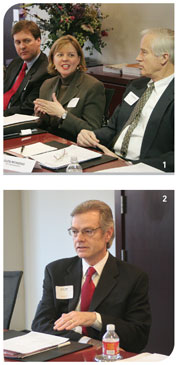Retail
Tom Turner questioned whether retail had reached a saturation point, specifically on 135th Street in Johnson County and at the Legends complex in Wyandotte County.
“We probably are pretty close to complete,” said Julie Jurden with RED Development. But as Jurden explained, the whole Village West complex is pretty close to a unique entity in its mix of retail, entertainment, sports, lodging and more. “It’s done quite a bit for the community out there,” added Jurden. “It has great synergy.”
As to 135th Street, John Sweeney of Terra Venture does not see the development of another continuous commercial corridor in the near future. As a result, South Johnson County commerce will continue to gravitate to 119th Street and 135th Street.
“I think if 135th Street is already not an infill site, it soon will be. I see demand being strong in the long haul,” said Sweeney optimistically, before adding, “You’ve got to weather the storm for a little while.”
Although largely agreeing with Sweeney’s point, Jon Copaken offered a cautionary note: “135th is too close to 119th Street, and there are only so many small shop tenants to go around.” Although the corridor has plenty of well designed, nicely conceived space, “It will be tough to get those projects to fruition.”

1: RED Development V.P. Julie Jurden discusses the successes that her organization has acheived with the Village West development in western Wyandotte County. Kevin Wilkerson of C.B. Richard Ellis (left) and Olen Monsees of B.A. Karbank & Company listen attentively.
2: Estel Hipp of Block & Company discusses the dynamics of development along the 135th Street corridor in Johnson County, Kansas.
Estel Hipp expects to see more developments on 135th Street like Hawthorne Plaza. “It started out as a non-anchor center; and it kept growing and growing and now they are the anchor.” In the beginning, Hipp joked, his wife used to say that the Einstein Brothers was the anchor tenant there because “that’s where she always went.”
“It makes me very nervous,” said Kathy Woodward of 135th Street. She noted that there were planned lifestyle centers from Metcalf to State Line in the 500,000 to 800,000 thousand square feet range. “There’s a lot of infrastructure there but not buildings,” she added. “I don’t know where you’re going to get all the people to build all that.”
With the exception of 135th Street, Tom Turner marveled at the success of all the new suburban lifestyle centers. “When I go by any one of those areas, they are packed with cars,” he observed. “So it seems like there was a pent-up demand.”
“Retailers are as interested or more interested in Kansas City today as they ever have been,” affirmed Bob Johnson. He believes that Shawnee, Lenexa, and the Northland still have a lot of great sites, and the key to development anywhere is a strong anchor.
As Julie Jurden observed, the very concept of “anchor” is changing. “The Great Wolf Lodge could be considered a type of an anchor or Dave & Busters. . . . The racetrack is an anchor. The arena is an anchor.”
“What Julie and her team at RED Development did at the Speedway is unbelievable,” confirmed Johnson.
Finding Downtown
Given all the new lifestyle centers flanking downtown Kansas City, Missouri from every direction, the question was raised as to whether downtown could generate enough traffic to work.
“I think it will work,” said Jon Copaken. He argued that the combination of eating, drinking, entertainment, and major events at Sprint Center will create a “different mix” than elsewhere, drawn in part from downtown residents, in part from convention visitors, and in part from other locals.
“It’s all the Kansas City experience,” said Carl LaSala of downtown. “If you are coming to Kansas City and you’re going to do the Kansas City experience, I think you’re going to do it all.”
Buzz Willard suggested that the people gathered at the table are not the natural demographic for downtown. “My daughters are in their 20s,” he noted. “They want that urban experience. That’s the market [developers] are trying to attract.”
Tom Turner spoke highly of attending a show at the Copaken Theater, which is attached to the new H&R Block building, and going out to eat afterwards nearby. “That is an experience that we really haven’t been able to have in this city anywhere,” he commented.
As Bob Johnson noted, the real anchors downtown for entertainment are the arena and the planned performing arts center. “Those are the ones that are going to bring the masses,” said Johnson. “The rest are going add to it, but those are the anchors.”
(...continued)